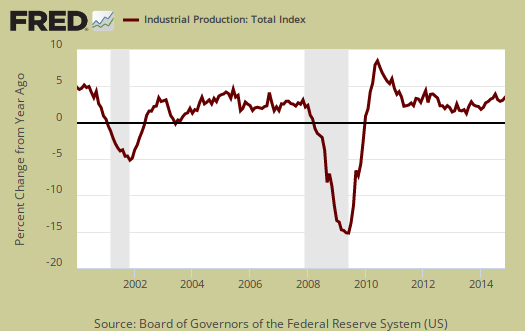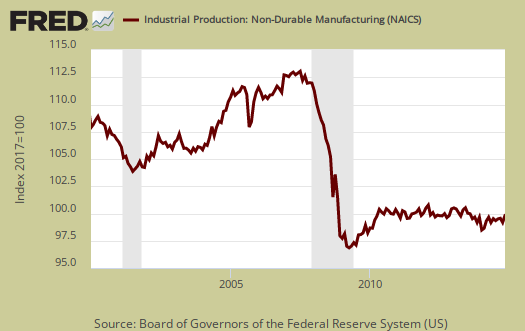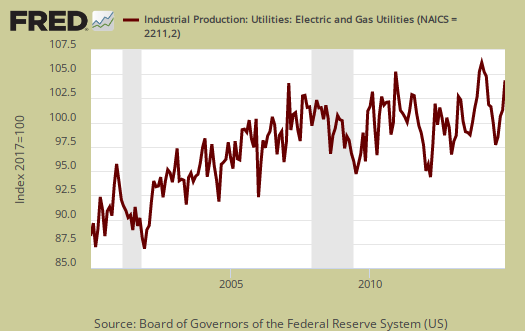Industrial production is on fire with a 1.3% November gain. Even better, the Federal Reserve Industrial Production & Capacity Utilization report shows upward revisions all the way back to June 2014. October was revised from a -1.0% decline to 0.1% growth. This month gains were across the board,, another good sign for the economy. Manufacturing alone grew by 1.1% and utilities jumped up 5.1% from October. Mining, which includes oil, decreased by just -0.1%. The sudden jump up in utilities is due to colder weather if one recalls the great freeze taking over the country in November. The G.17 industrial production statistical release is also known as output for factories and mines. This is the largest industrial production monthly gain since October 2005.

Total industrial production has now increased 5.2% from a year ago. Currently industrial production is 6.1 percentage points above the 2007 average. Below is graph of overall industrial production's percent change from a year ago.

Here are the major industry groups industrial production percentage changes from a year ago.
- Manufacturing: +4.8%
- Mining: +9.3%
- Utilities: 1.8%
Manufacturing output is finally above it's peak 2007 Level. This is an enormous amount of time for factory output to recover but finally it has. Motor vehicles and parts skyrocketed 5.1% with 900,000 vehicle body assemblies manufactured.

Within manufacturing, durable goods increased 1.0% for the month. Beyond motor vehicles & parts, durable goods machinery and wood products both increased more than 1.0% for the month.

Nondurable goods manufacturing also increased more than 1.0% for the month. Shocking in that petroleum production increased 2.0% as did coal. Apparel and leather also increased more than 2.0% with food and beverages increasing 1.4%. The below graph shows nondurable goods.

Mining with U.S. oil & gas production has been growing, although considering the free fall in oil prices we expect mining to decline in future. Mining showed a -0.1% monthly decrease and for the year has increased 9.3%. Mining includes gas and electricity production.

Utilities are volatile due to weather and why the below graph shows the wild swings. Track the polar vortexes and heat waves in the below graph.

There are two reporting methodologies in the industrial production statistical release, market groups and industry groups. Market groups is output bundled together by market categories, such as business equipment or consumer goods and shown below:
In November, the indexes for all of the major market groups advanced. The gain of 2.5 percent in consumer goods was its largest since August 1998. The production of all major durable and nondurable categories of consumer goods rose, with the largest increases registered by consumer energy products and automotive products. The output of business equipment moved up 1.2 percent because of sizable gains for transit equipment and for industrial and other equipment. The index for business supplies rose 1.2 percent, its second strong increase in the past three months. The production of materials advanced 0.8 percent, with substantial gains in the indexes for all of its major categories.
Capacity utilization, or of raw capacity, how much is being used, for total industry is 80.1%, a 0.8 percentage point monthly increase. How much plants are utilized is now equal to the long run 1972 to 2013 average. Capacity utilization has increased 0.6 percentage points from a year ago. Manufacturing capacity utilization is 78.4% and is 2.0 percentage points higher than a year ago. Mining capacity utilization is 87.9% and is up only 0.1 percentage points from a year ago. Utilities use of it's capacity is 81.8% and is up 0.6 percentage points from a year ago. Manufacturing is still 0.3 points below the long term average (1972-2013).
Capacity utilization is how much can we make vs. how much are we currently using, of what capacity is available now, or output rate. Capacity utilization is also called the operating rate. Capacity utilization is industrial production divided by raw capacity.

Capacity growth is raw capacity and not to be confused what what is being utilized. Instead, this is the actual growth or potential to produce. Capacity is the overall level of plants, production facilities, and ability to make stuff, that we currently have in the United States. Capacity growth overall has increased 3.1 percentage points from a year ago. Below is the capacity growth increase from a year ago of the subcategories which make up industrial production.
- Manufacturing: +2.2%
- Mining: +9.2%
- Utilities: +1.0%
Below is the Manufacturing capacity utilization graph, normalized to 2007 raw capacity levels, going back to the 1990's. Here is where offshore outsourcing really shows up. Pay particular attention to the 2001-2003 as manufacturing had a mass exodus to China after passage of the bad trade deal in 2000.

Here are our previous overviews, only graphs revised. The Federal Reserve releases detailed tables for more data, metrics not mentioned in this overview.

Recent comments